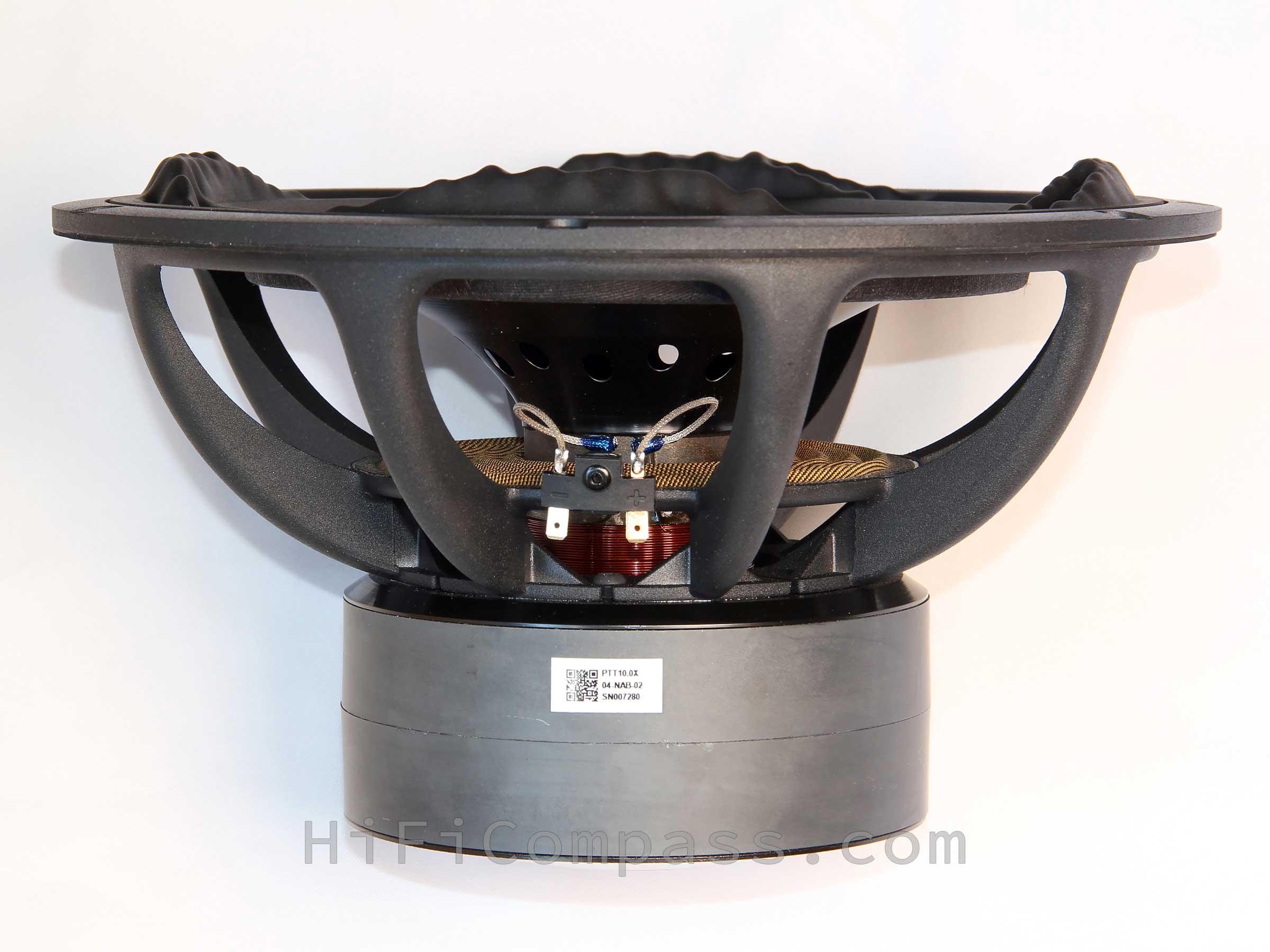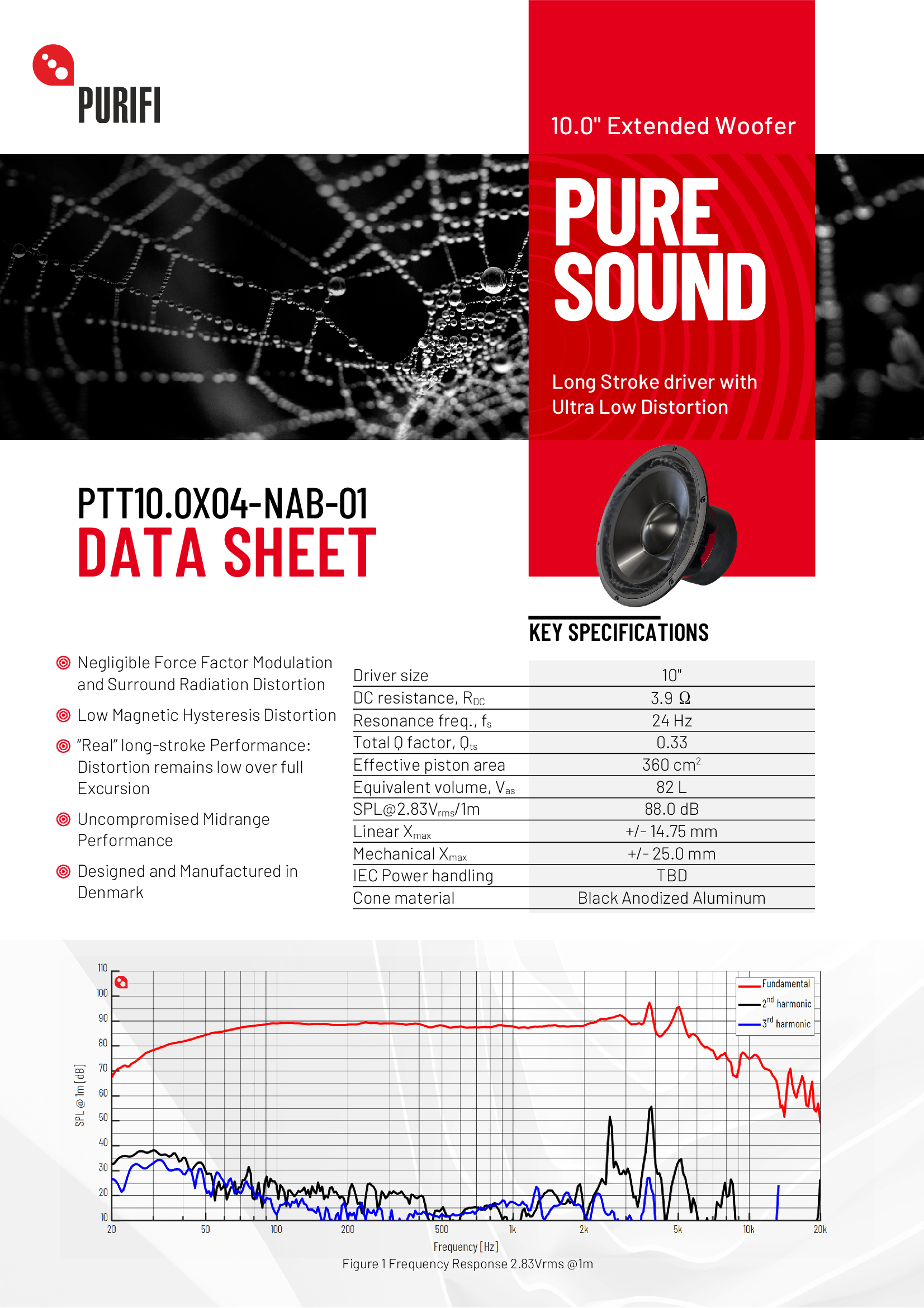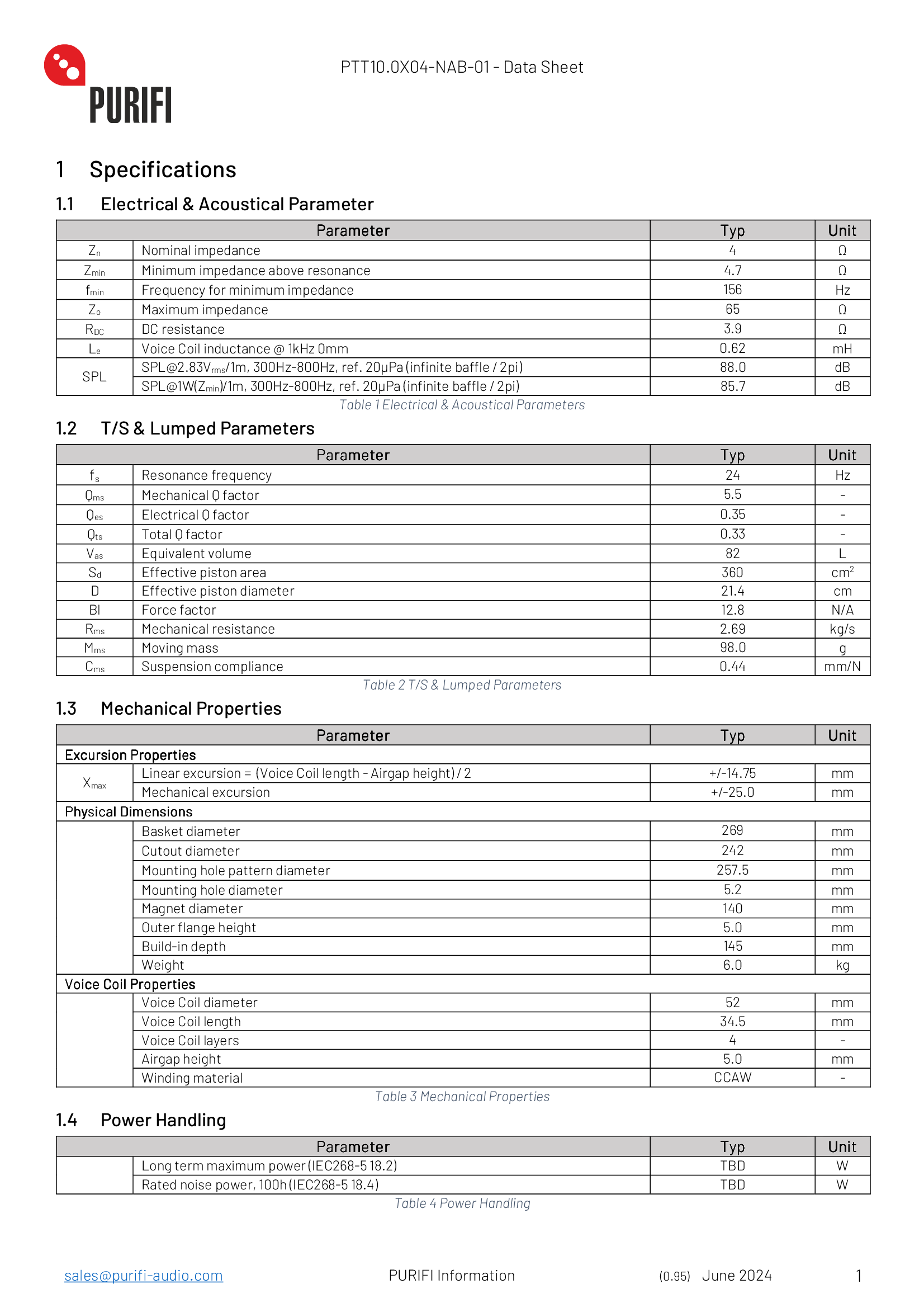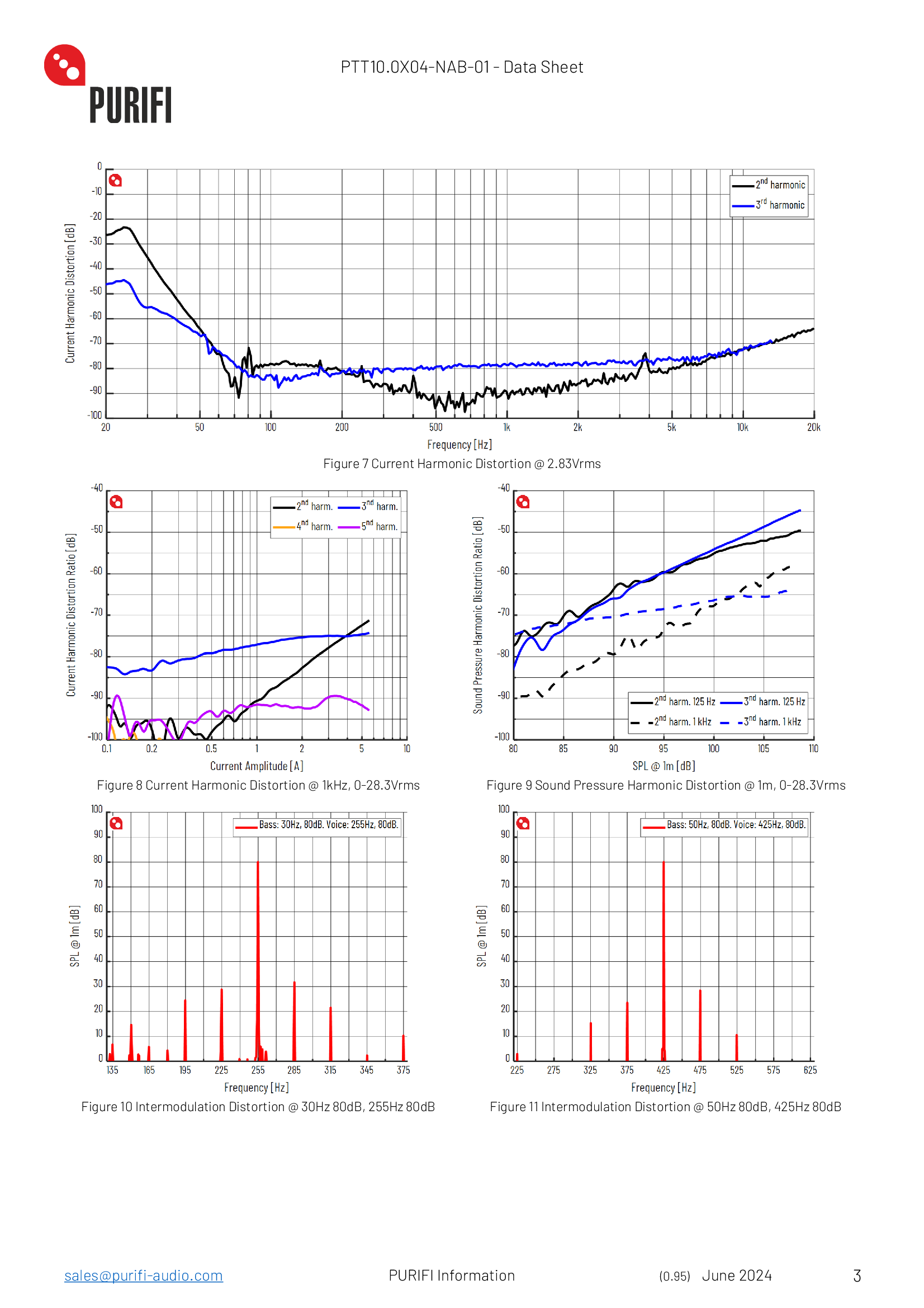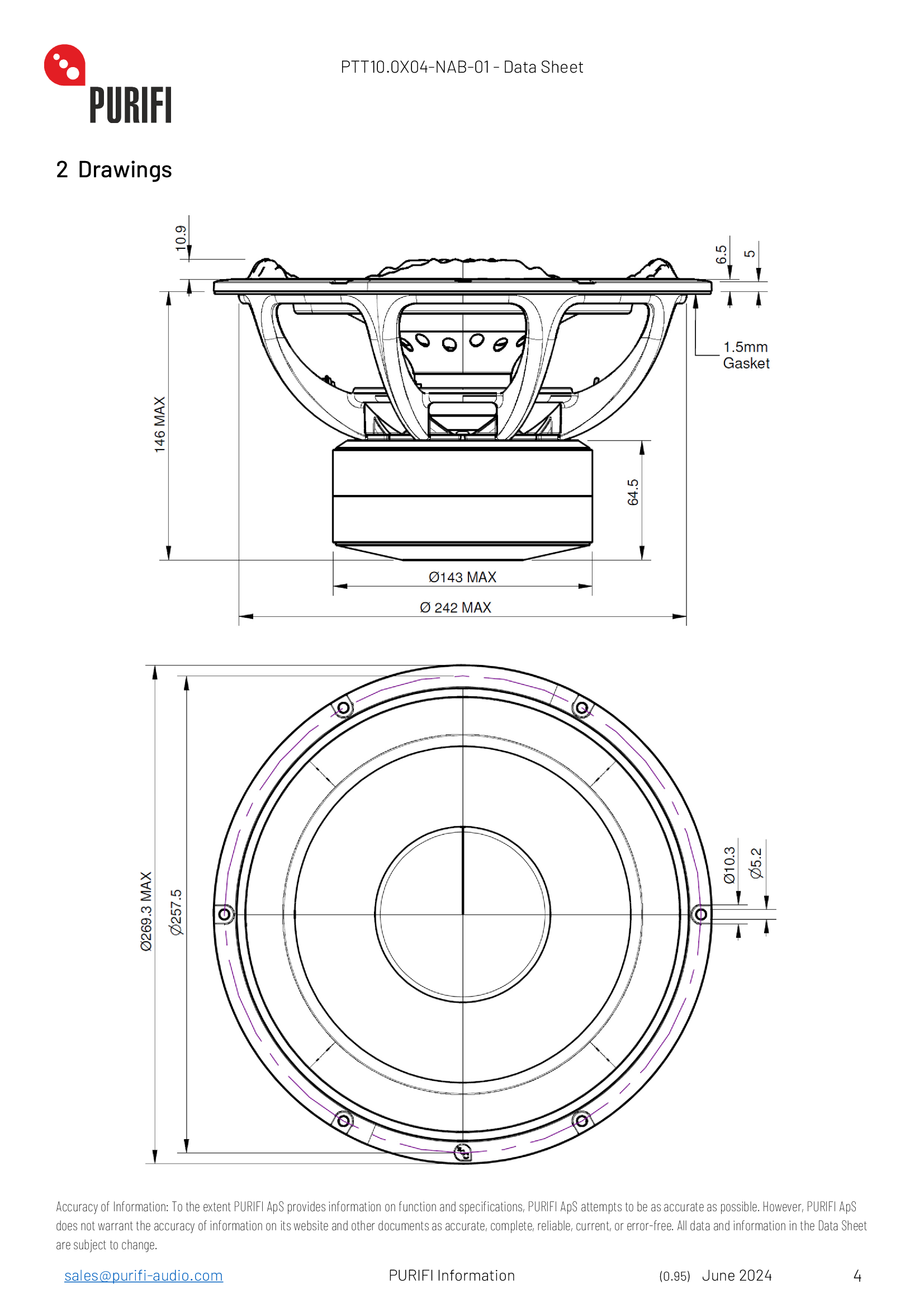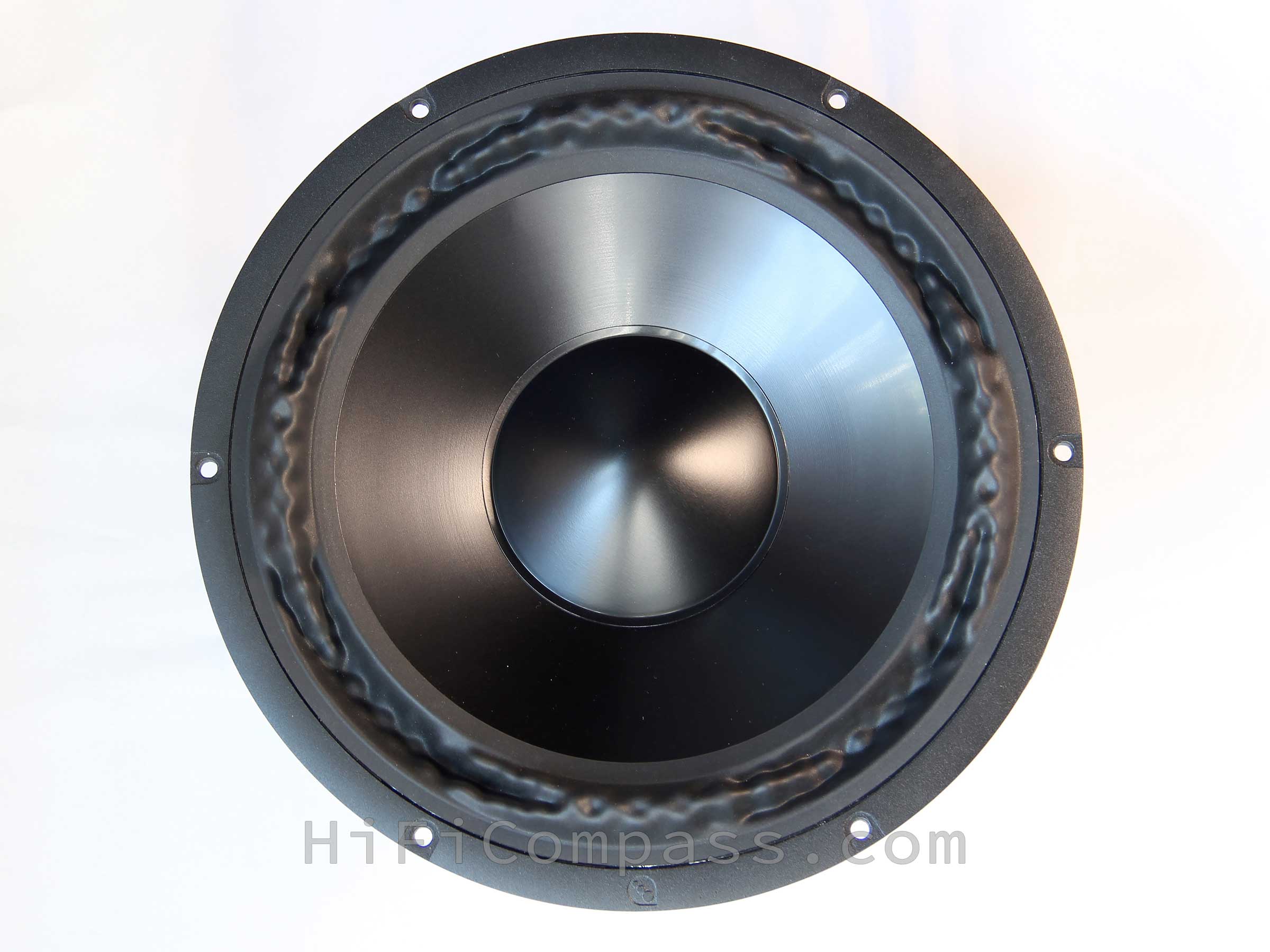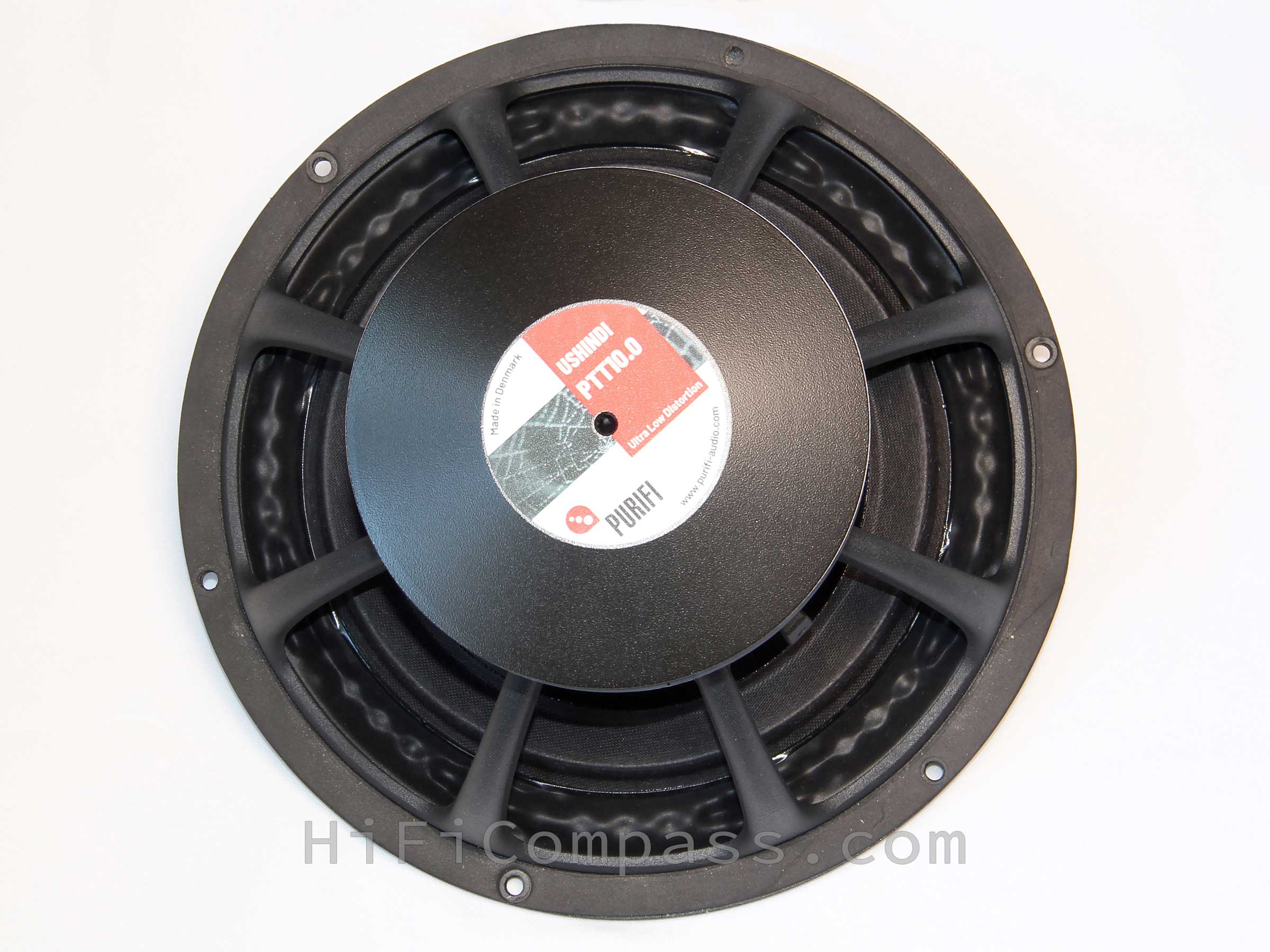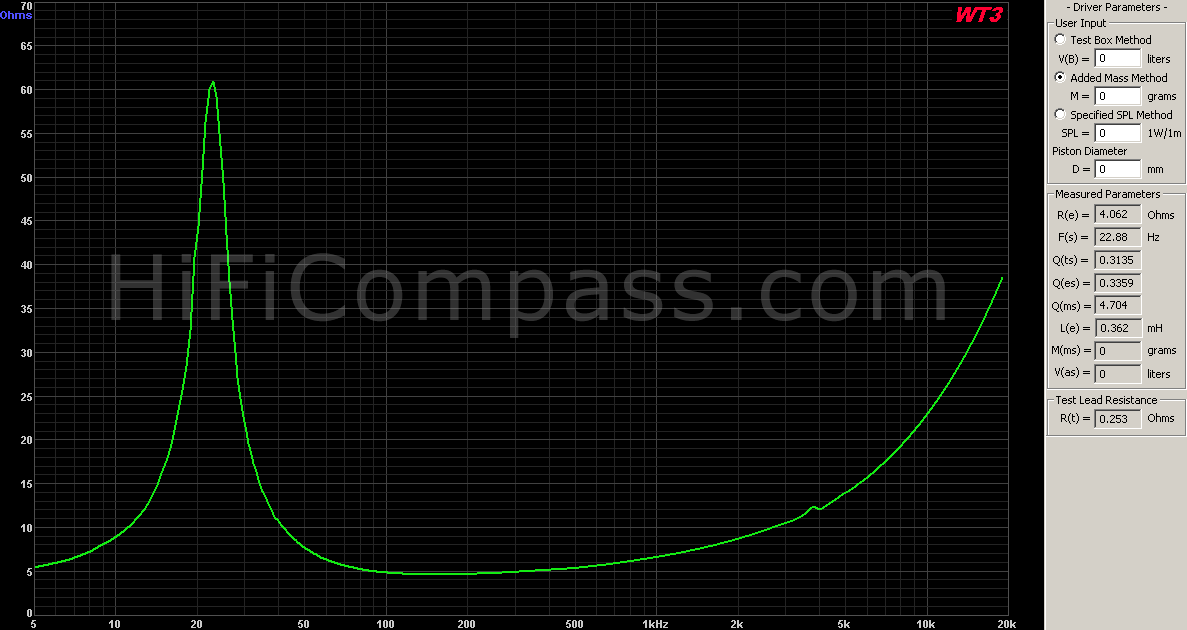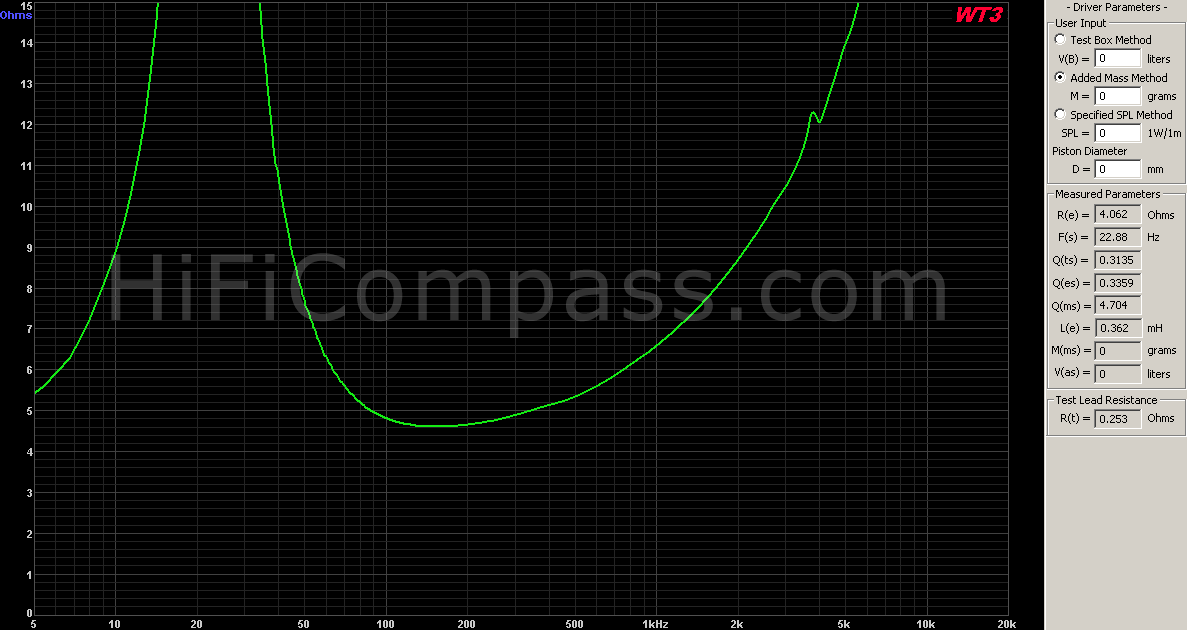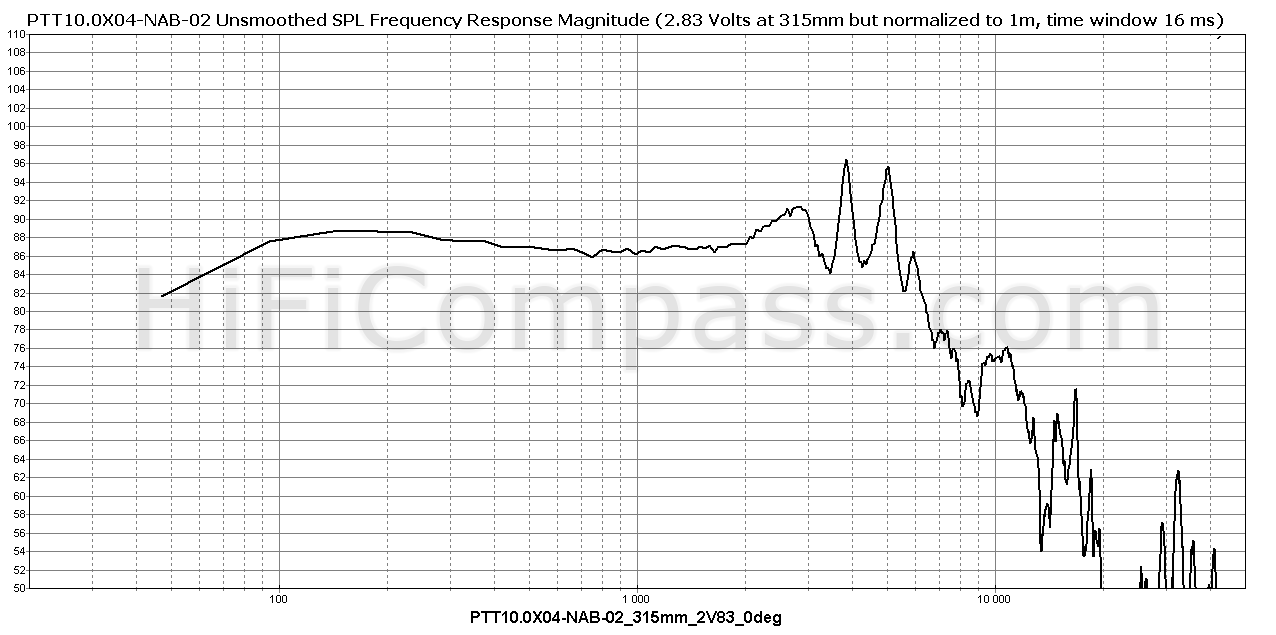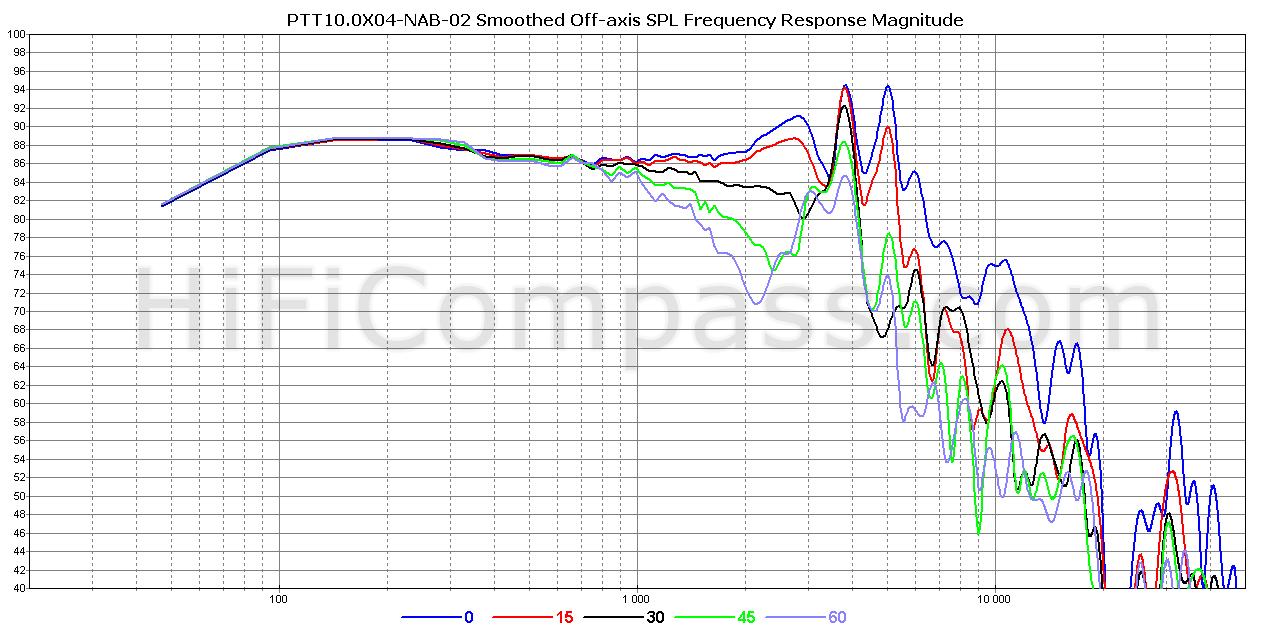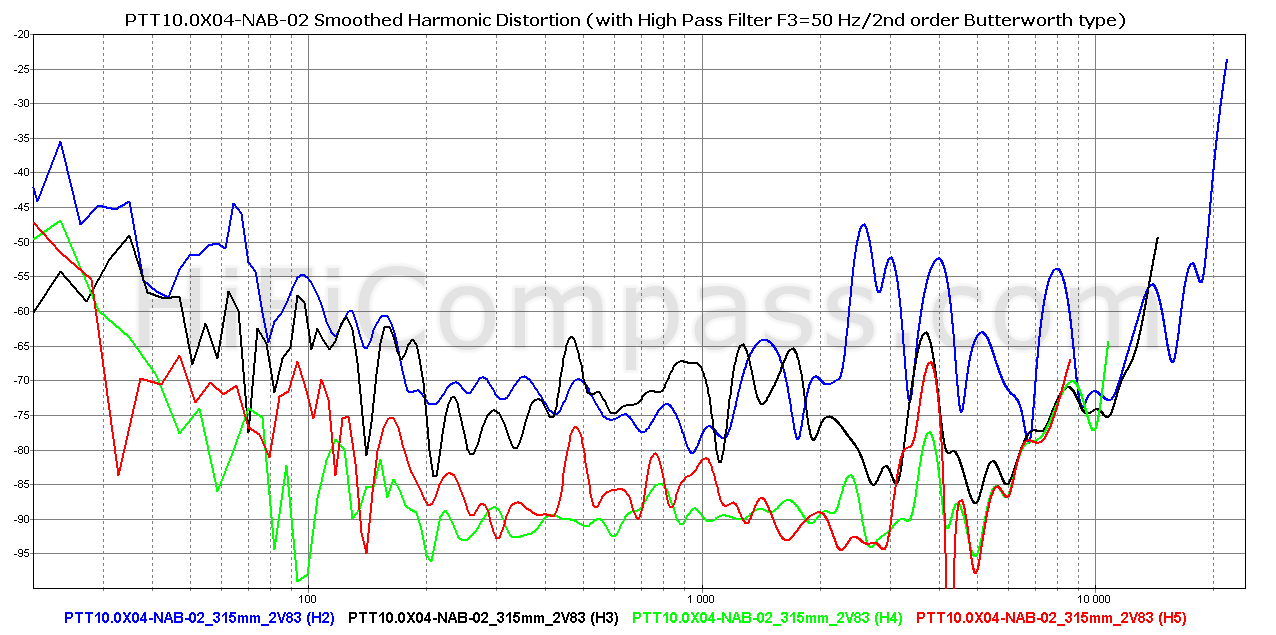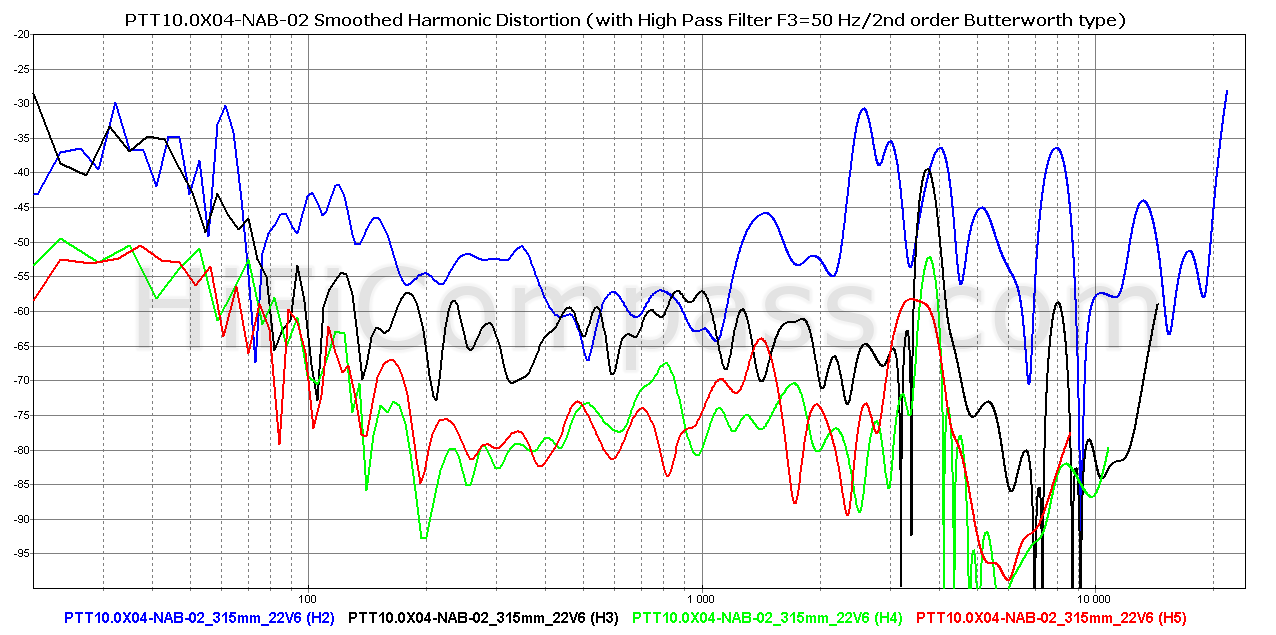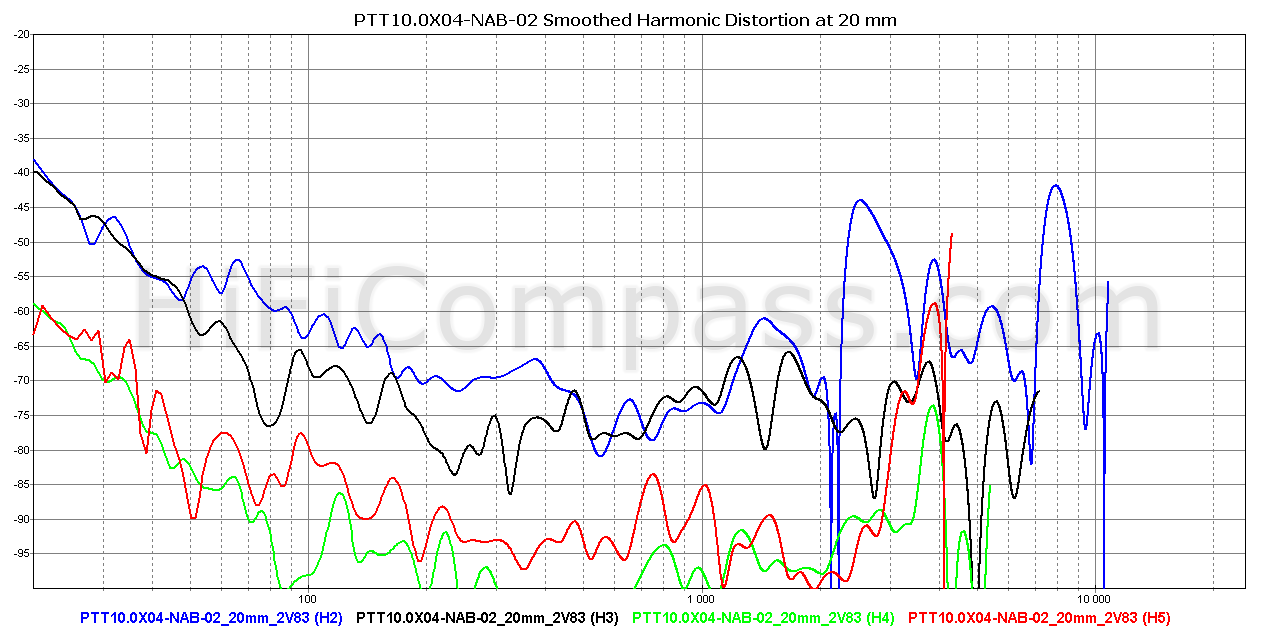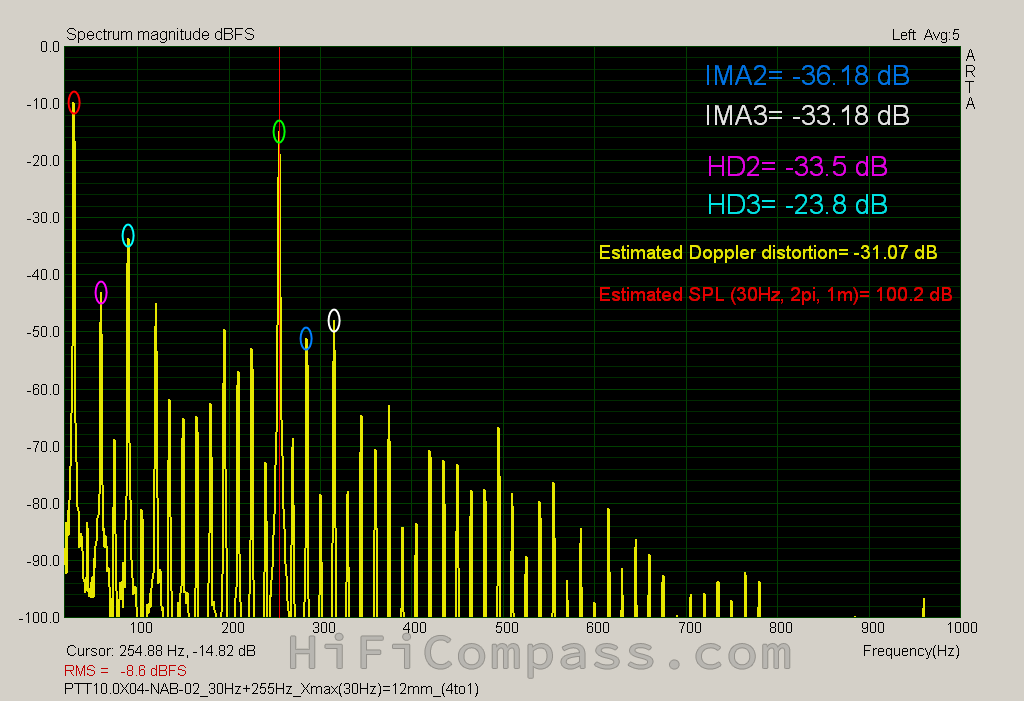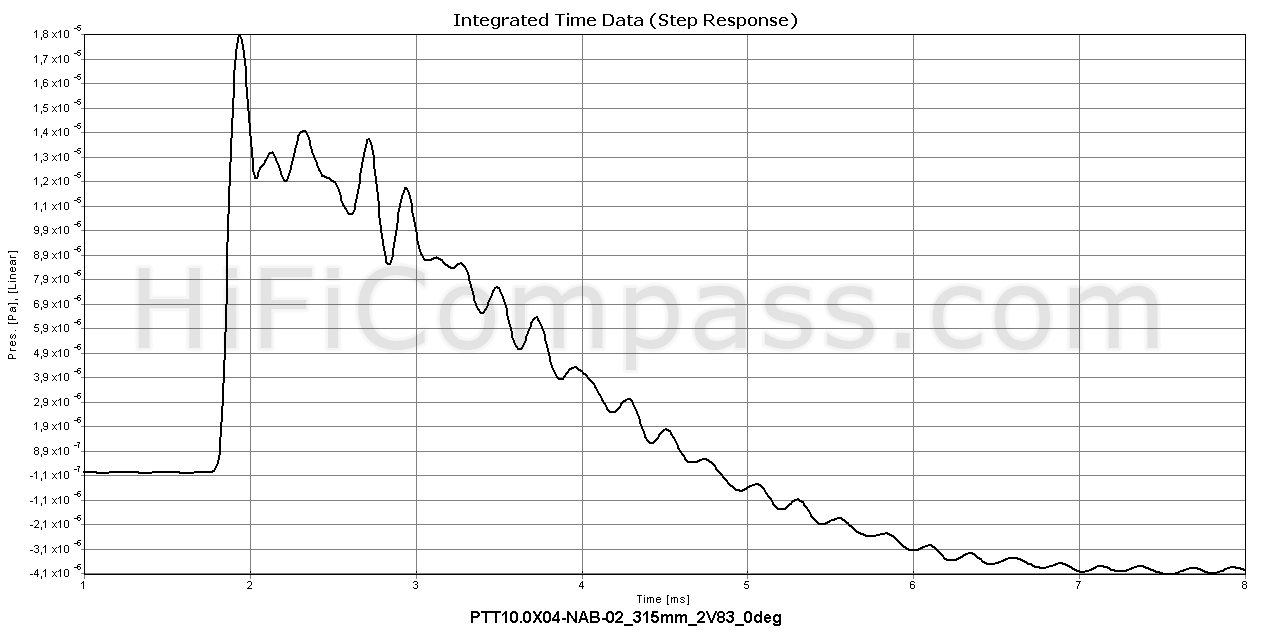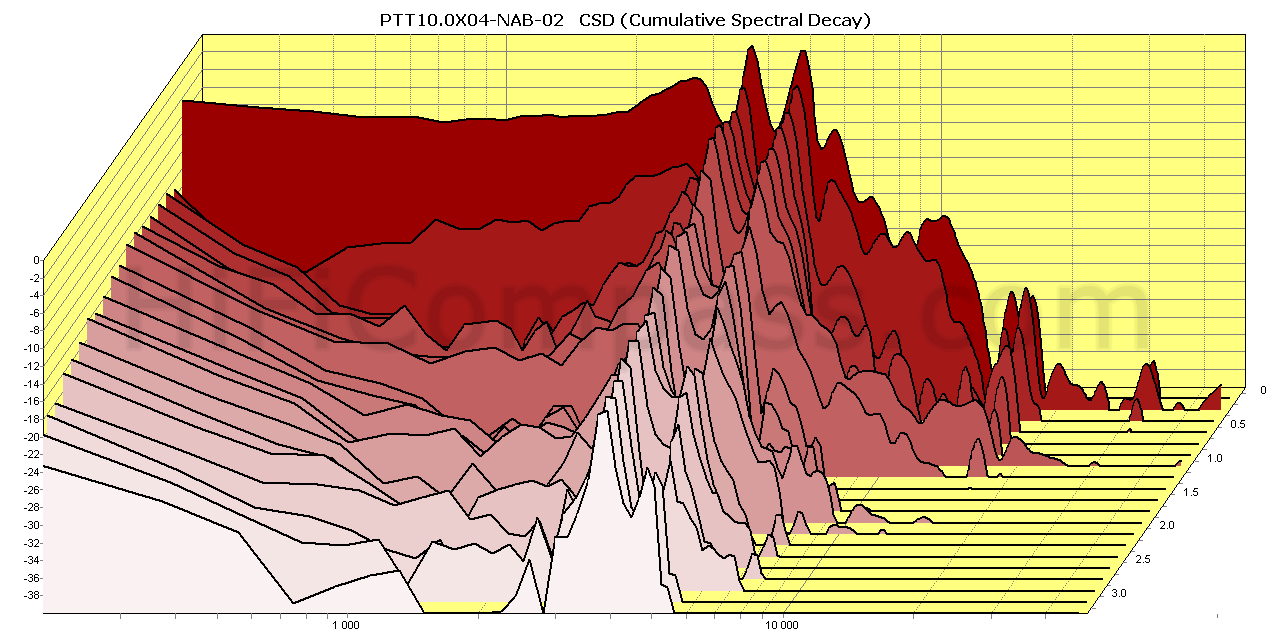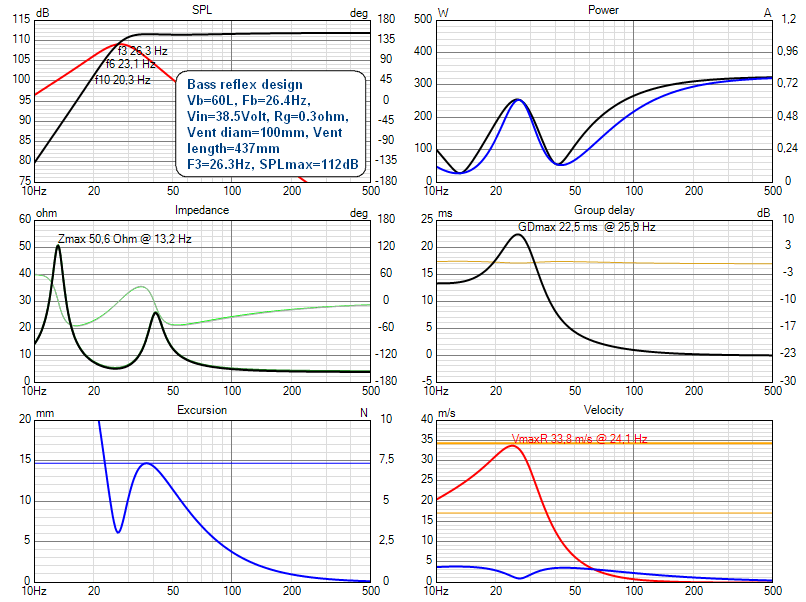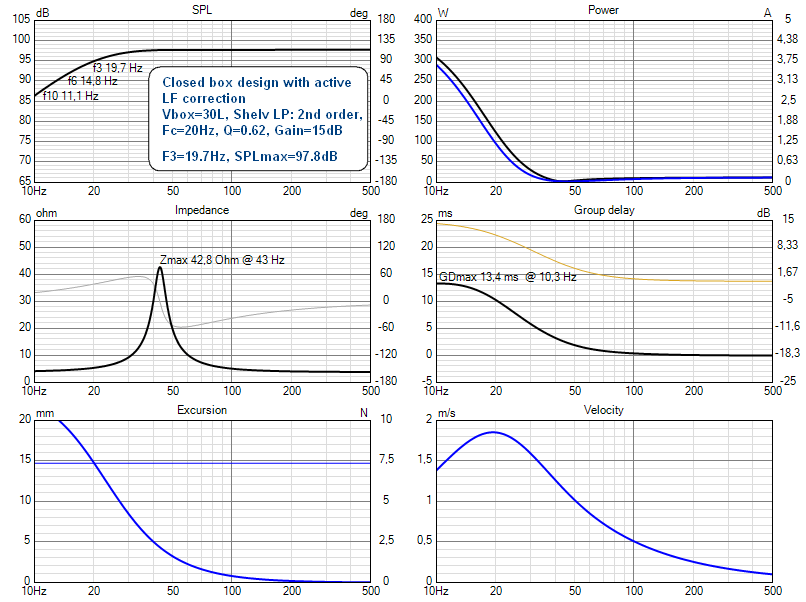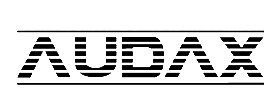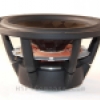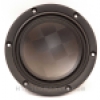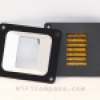HiFiCompass
Purifi PTT10.0X04-NAB-02 10" Aluminum cone woofer
Finally, a year after its announcement in May 2023, a new speaker from the Danish company PURIFI has reached me. This announcement caused a great excitement in narrow audiophile circles and intense salivation among DIYers and loudspeaker manufacturers all over the world. The latter were luckier - they started to receive OEM versions for their products by the end of last year, but mere mortals will have to wait until the beginning of the third quarter of 2024. That's okay, we'll wait, it won't be long now.![]()
You can read the history of the PURIFI company here.
What did the manufacturer state?
PURIFI has the most detailed and informative datasheets of any company I know of. In them you can find everything you need to design loudspeakers and even more.
In addition to very familiar plots of the axial SPL frequency response and the impedance frequency response, the following have been added:
- Force Factor and Stiffness vs Voice Coil Position
- Inductance vs Voice Coil Position
- Current Harmonic Distortion @ 1 kHz, 0-28.3 Vrms
- Sound Pressure Harmonic Distortion @ 1 m, 0-28.3 Vrms
- Intermodulation Distortion @ 30 Hz 80 dB, 255 Hz 80 dB
- Intermodulation Distortion @ 50 Hz 80 dB, 425 Hz 80 dB
Of the woofer's parameters the following should be noted:
- Inductance of 0.62 mH is a very low value for a four-layer voice coil 34.5 mm long and 52 mm in diameter!
- Acceptable sensitivity - 88 dB/2.83 Volts*1m
- One way linear excursion of 14.75 mm (!) is very high value, it is a true long-stroker
- The mass of the moving system is 98 grams - about twice the weight of a traditional 10" woofer and more typical for a long-stroke subwoofer division, for example:
- Scan-Speak 26W/4558T (Mms=105 grams, Xlin=+/-12.5 mm)
- Scan-Speak 28W/4878T00 (114.5 grams, +/-14 mm)
- SEAS L26RO4Y (160 grams, +/-15 mm)
- Morel TICW1058 (105 grams, +/-10.5 mm)
As I noted, externally, the speaker design, is completely identical to the previous smaller 6.5" and 8" models, except for the dimensions.
- Workmanship - all at the highest level. No traces of glue, scratches, dirt or dust, spots and dents on the cone, chips on the ferrite magnet, gaps and skewness anywhere. There is nothing to complain about
- The basket - is aluminum alloy diecast with black microtextural powder coating. Acoustically very transparent. It is fixed to the magnet system by glue and four screws.
An interesting detail - the basket base, which is attached to the magnetic system, has a form not like a continuous ring, as in majority of other speakers, but has cuts between the ribs. The thing is that a solid basket base forms a short-circuited loop, which introduces asymmetry into the magnetic field at a large voice coil stroke, therefore to eliminate this effect the ring here was made split. Even this seemingly small detail was given attention during the development - The top and bottom plates of the magnetic system are made of metal, powder-coated black to improve heat dissipation and corrosion protection
- The magnet is made of ferrite, nothing special here
- The surround is very unusual. It is made of NBR rubber and in its shape resembles alternating mountain ridges. The four ridges look outward and other fours inward. The surround is absolutely symmetrical relative to the basket flange plane. This is the principle of PURIFI Neutral Surround - it is symmetrical, unlike conventional half-roll surround, so the effective radiation area remains constant throughout the entire voice coil excursion. In traditional half-roll surrounds the radiation area increases during the inward voice coile movement and decreases when moving outward, introducing additional nonlinearity.
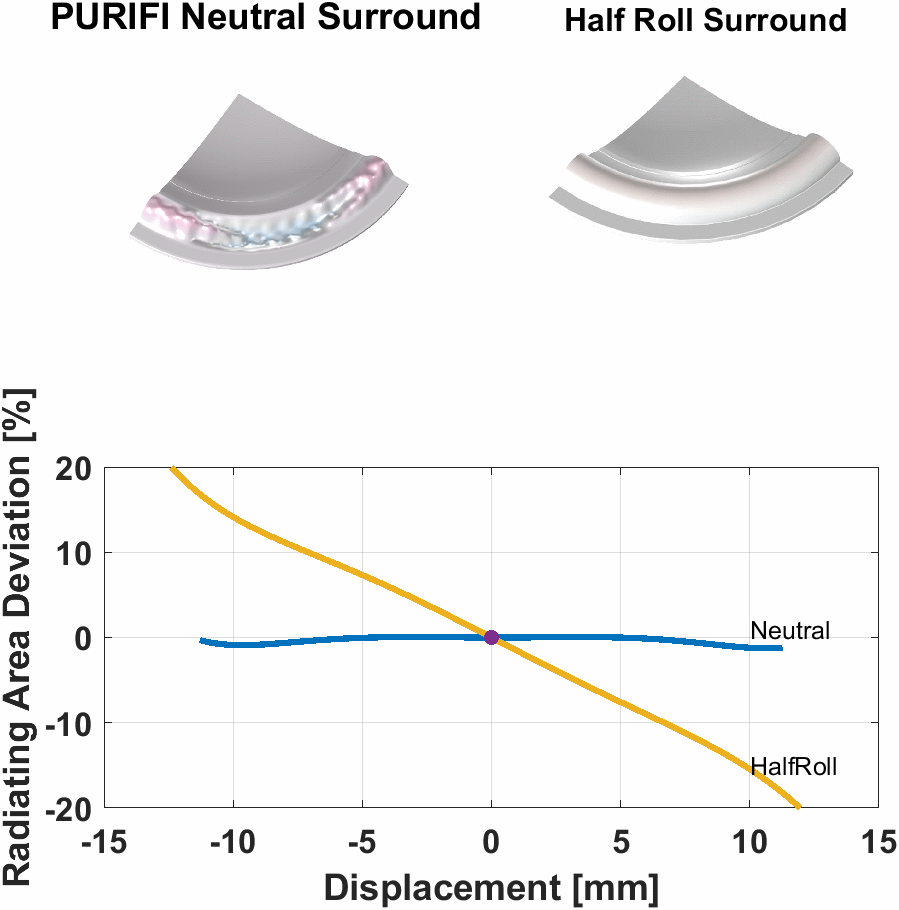
Lars Risbo recently posted an animation showing a visualization of a conventional half-roll surround and the original PURIFI Neutral Surround, as well as a comparison of the relative change in the effective area of a cone with displacement. Let me attach it here for a better understanding of how it works.
For more information on this subject, I recommend reading the PURIFI patent -
The cone is made of aluminum and is protected from corrosion by deep anodizing in black with a pleasant silky semi-gloss sheen. The profile of the cone has a barely noticeable curvature. On the side of the neck, the cone has many holes for ventilation of the space under the dust cap.Also, as in the paper version, a paper stiffening rib of a triangular profile is glued along the edge of the back side of the cone. This helps increase the stiffness of the cone for combat the well-known "cone edge/surround" resonance and cone bending due nonuniform force from a neutral surround
- The dust cap is convex, with a variable curvature of the profile, resembling a bullet. It is made of the same material as the cone
- The lead wires are silver plated
- The terminal block looks worthy and matches the status of the speaker. It is made of thermosetting plastic with gold-plated knife terminals molded into it
- The spider is made of BIMAX material. BIMAX is known for its durability and increased resistance to mechanical stress
- The voice coil former is made of fiberglass. It is also a very popular non-conductive material, which allows to avoid additional losses from eddy currents, as in the case of aluminum formers, and to maintain high mechanical quality factor of the moving system. The former doesn't have ventilation holes
- The voice coil is very long, 34.5 mm, and protrudes noticeably out of the magnetic gap. The four-layer voice coil is wound with copper clad aluminum wire (CCAW) with variable pitch, which is one of the secrets of obtaining high linearity of BL(x) and Le(x) over the entire excursion range
Generally speaking, there are not the slightest complaints about the design of the speaker. The design and workmanship are at the highest level.
The diagrams below show, at different scales, the impedance frequency response after the woofer have been good "broken-in" with a sinusoidal voltage of 13 Volts/24 Hz for 30 minutes:
The measured values of the resonant frequency Fs=22.88 Hz and total quality factor Qts=0.3135 slightly lower the declared values Fs=24 Hz and Qts=0.33. Taking into account that in the process of "broken-ing" the ratio "Fs/Qts" remains practically constant, then at less intensive "broken-ing" the resonant frequency and quality factor will transpose to Fs=24 Hz and Qts=(24/22.88)*0.3135=0.329, which coincides absolutely perfectly with the datasheet!
The impedance curve is very smooth over the entire frequency range, except for a small peak at 3.8 kHz, which accompanies the main cone resonance and is outside the potential operating frequency range. I would be very surprised if the impedance of a 10" aluminum woofer had no spike at all.![]()
The increase in impedance with increasing frequency is quite moderate, especially for a woofer of this caliber with a four-layer voice coil. This is due to the low inductance, which in turn is due to the large amount of copper in the motor. Low inductance and its excellent stability regardless of the position of the voice coil in the magnetic gap contribute to a significant reduction in nonlinear distortion.
Frequency dependence of impedance is a visiting card of a speaker and says a lot. In this case, it's about a low-loss moving system (high Qms), a well-balanced cone and an advanced motor. Great!
On-axis frequency response (at 315 mm)
The diagram below shows the axial magnitude frequency response of a woofer without smoothing, measured in a test baffle:
The measured sensitivity in the range from 300 Hz to 800 Hz averaged 87 dB, which is 1 dB below the stated value.
In the range from 100 to 2000 Hz the response is quite flat and very smooth, the unevenness does not exceed +/-1.25 dB.
A small smooth rise is observed in the range of 90-400 Hz. Starting from 2 kHz the cone begins to enter the break-up mode, which is accompanied by a series of resonance bursts on the frequency response. As we can see, the break-up mode is very well controlled and manifests itself with only a couple of narrow and not very high peaks at 3.8 kHz and 5 kHz. Considering that they are far beyond the potential operating frequency range of the woofer, they can be ignored altogether.
I would like to note the magnitude frequency response is almost flawless in very wide range, especially for 10" caliber, as well as excellent behavior of the cone in the break-up mode. With such behavior this woofer is formally even suitable for a two-way loudspeaker.![]() Super!
Super!
Off-axis frequency responses (at 315 mm)
Up to 2 kHz, the off-axis responses behave perfectly, decreasing uniformly and monotonically with deflection angle and frequency. Above 3 kHz, in the break-up mode of the cone, the off-axis behavior is already a bit chaotic. No additional hidden resonances were detected.
Harmonic distortion (at 315 mm)
Above are harmonic distortion curves for average sound pressure levels of 87 and 105 dB. To limit the speaker overload in terms of power and cone displacement amplitude when measuring harmonic distortion, a second-order digital high-pass filter with cutoff frequencies of 50 Hz (at 2.83 Volts) was used. In these graphs, we analyze the frequency range only from 200 Hz and above.
At low sound pressure levels, the 2nd harmonic competes with the 3rd, but at higher levels it already dominates, and this is good, since of all the harmonics it is the least unpleasant to the ear.
Overall, the harmonic distortion level in the 200-2000 Hz range is extremely low, the lowest I've seen in a 10" speaker to date. Funny enough, at the SPL of 105dB it has even lower distortion than some of its competitors at 90dB! Compare it to the Accuton S280-6-282, SEAS CA26RFX, ScanSpeak 26W/4534G00, Eton 11-612/C8/50RP, for example.
The harmonic distortion measurements are close to those published in the datasheet. Excellent!
Harmonic distortion (at 20 mm)
Due to the specifics of my test setup, to analyze the nonlinear distortion of woofers in the frequency range up to 200 Hz it is more correct to use the results obtained by measurements in the near field at a distance of 5 to 20 mm from the cone. The diagrams below show harmonic distortion at voltages of 2.83 and 16 Volts:
We see the typical increase in distortion with decreasing frequency, especially below 100 Hz. The overall level of harmonics below 100 Hz, as for a 10" woofer, can be characterized as "very low", probably the lowest I've seen in a 10" bass driver so far.
Considering that the sensitivity of the human ear to harmonic distortion drops off significantly in the very lowest frequencies, I can say that the distortion levels of HD2=-28 dB and HD3=-22 dB at 16 Volts are quite acceptable at 20 Hz. This corresponds to an SPL of about 93 dB at 1 m for a single woofer and 99 dB for a pair in a stereo system - an excellent result. In terms of harmonic distortion, the PTT10.0X04-NAB-02 can be used safely down to 20 Hz and serve as the basis for a large-scale full-range multi-way loudspeaker.
Voice coil current harmonic distortion
This type of measurement, despite its simplicity, is an excellent tool for assessing the linearity of a speaker motor. The above plots show the frequency dependences of the 2nd, 3rd, 4th and 5th harmonics of the voice coil current at 1.41 and 8 volt. To limit the speaker overload in terms of the cone displacement when measuring harmonic distortion, a second-order Butterworth type high-pass filter with a cutoff frequency of 20 Hz was used.
Voice coil current nonlinearity is the direct nonlinearity of the mechanical force driving the speaker cone, since this force is related to the current by a simple relationship F=B*L*I, where B is the magnetic field strength, L is the length of the voice coil wire inside the magnetic gap and I is the current. The level of current distortion largely determines the minimum level of distortion that can be obtained from a speaker.
With decreasing frequency and increasing voltage, the amplitude of the cone oscillations increases and becomes closer and closer to its linearity limit, therefore, below 100 Hz, a sharp increase in harmonics of all orders begins. In the range above 200 Hz, even at 11.2 Volts, the 2nd, 3rd and 5th harmonics have very low values, and the 4th is generally below minus 100 dB. A magnificent result!
The intermodulation distortion measurement is one of way of to analyze the device non-linearity. It is not an alternative, but an additional method and allows you to identify the spectral components of the inharmonious structure, which are much more harmful for high-quality sound reproduction and to which our hearing is more sensitive.
There is a very good article of Bruno Putzeys - "Distortion, The Sound That Dare Not Speak Its Name", where he very well describes the mechanism and origins of the intermodulation distortions in a woofer, as well as introduces one interesting testing experiment that everyone can do. Its essence is the simultaneous supply of a musical signal to a woofer such as singing (rather than a speech, for better audibility of the effect) male or female vocals, or a violin, clarinet, flute, and sine wave signal with frequency of 30 Hz, the level of which can be adjusted. The sine signal causes a large cone excursion, which leads to the appearance of non-linearity of the suspension and the force factor. The suspension nonlinearity leads only to the appearance of harmonic distortions of the 30 Hz sine signal and does not affect the reproduction of midrange, while the modulation of the force factor leads to a change in the sensitivity of the speaker for midrange frequencies. This changing is manifested in the amplitude modulation of the voice notes with 30 Hz sine. Try this experiment yourself and you will be very surprised how audible intermodulation distortions are and how they grow with an increase of the low-frequency component. Perhaps this will be a great discovery for you.
For testing I chose the frequencies of 30 Hz and 255 Hz. With this ratio (1:8.5) the contribution of the Doppler distortion is not yet dominant and the contribution of amplitude modulation can still be observed. In addition, this is a very realistic situation that occurs in both two-way and three-way systems. The measurements were performed for different 30 Hz cone excursions and their conditions are indicated in the lower left corner of each plot. By various colors are indicated:
- test frequencies
- 2nd order harmonic distortion components for the test frequencies (2nd HD)
- 3rd order harmonic distortion components for the test frequencies (3rd HD)
- 2nd order intermodulation distortion components (IMA2)
- 3rd order intermodulation distortion components (IMA3)
The graphs above show the IMD spectrum for 2 mm and 12 mm cone excursion with a 30 Hz modulating signal.
However, in these plots products of the motor nonlinearity are mixed with products of inevitable frequency modulation of the Doppler effect. How do you define who is who? We can analytically estimate the level of the first pair of the side Doppler components using the following formula [http://www.linkwitzlab.com/frontiers.htm#J]:
As(dB) = 20*log10(pi*A1*f2/c), where pi=3.14, A1- the modulating signal amplitude in meters, c=343 m/s, f2 - carrier frequency. In our case f1 = 30 Hz, f2 = 255 Hz.
Aplying the last formula we get the maximum level of spectral components corresponding to Doppler distortion is approximately as follows:
d.f. (2 mm) = -46.64 dB (IMA2-Doppler)
d.f. (12 mm) = -31.07 dB (IMA2-Doppler)
It can be seen from the graphs that the levels of the measured spectral components for PTT10.0X04-NAB-02 at different amplitudes of the modulating signal are:
For 2 mm = -43 dB (IMA2)
For 12 mm = -36.18 dB (IMA2)
At an amplitude of 2 mm, the level of second-order intermodulation distortion was 3.36 dB higher than Doppler distortion, and at an amplitude of 12 mm it was already 5.15 dB lower. This means that at low volume the amplitude modulation slightly dominates the frequency modulation, and at medium volume and above the fundamentally unrecoverable frequency modulation completely dominates the amplitude modulation determined by the speaker motor nonlinearity.
I also decided to measure intermodulation distortion for a pair of frequencies of 50 and 425 Hz. The datasheet for this type of measurements does not standardize the cone amplitude but the sound pressure of 80 dB at a distance of 1 m when radiating into a half space. I performed measurements for cone amplitudes of 1 mm and 6 mm, which, according to calculations, should create a sound pressure of 87.48 dB and 103 dB (1m, half space):
For the frequency pair 50+425 Hz at small and large cone amplitudes, the level of intermodulation distortion was slightly higher than the threshold values of Doppler distortion, only by 4.3 and 3 dB. A very good result.
You may ask, what difference does it make, what mechanism is the source, because the parasitic spectrum still appears? The fact is that there is an assumption that our hearing is much less susceptible to a frequency modulation compared with an amplitude one. There is an interesting article published in the Stereophile on Doppler distortion and its audibility - Red Shift: Doppler distortion in loudspeakers, and also a must-read topic from the PURIFI blog - Doppler distortion vs IMD?
Good step response - fast front, monotonous decay, no overshoot or spikes. Slight waviness in the decaying part is due to the cone resonances in the break-up mode. After filtering in the crossover, there will be no trace of it, so you should not pay attention to it.
The waterfall shows the same effects as a step response, in addition exposing hidden resonances that are difficult to see in other types of measurements. In this case, no new problematic resonances were found.
The waterfall is very clean up to 3 kHz, followed by a couple of long ridges caused by the inevitable resonances of the aluminum cone. But this is a woofer, guys![]() . A very clean waterfall up to 3 kHz - Excellent!
. A very clean waterfall up to 3 kHz - Excellent!
As usual, after completing the measurements, I spent some time listening to the woofer in the test baffle on a wide variety of musical material. I listened to it in full range and with low-frequency filtering LR2/150 and LR2/300 using DSP. Describing the sound of the woofer outside a loudspeaker is not the best pleasure, but nevertheless, I will try to draw some conclusions.
The woofer impresses with its extremely low aerodynamic noise of the moving system, even at maximum cone excursions. This is clearly audible when the woofer is simply lying on the floor and powerful low-frequency signals are fed to it. Very often, in woofers, even at excursions twice lower than the maximum linear value, some extraneous noises are heard, whistling of air flows in the motor, extraneous sounds from lead wires, and the like, especially with dynamic sound signals. When the speaker is installed in a test baffle or an enclosure, this is not audible, but when it is in your hands or on the floor it is very much so. The PTT10.0X04-NAB-02 is absolutely fine with this, it is simply silent.
The bass guitar is dynamic and clearly articulated, the double bass is embossed and elastic, the bass drum has an impact and fullness. Oh, this is a completely different caliber, not 6" and not 8". This is ten inches, guys![]() , with a blow of 15 mm and a resonant frequency of 20 Hz. It is audible and well audible, and even can be felt. Surprisingly, at any volume level there is absolutely no audible distortion.
, with a blow of 15 mm and a resonant frequency of 20 Hz. It is audible and well audible, and even can be felt. Surprisingly, at any volume level there is absolutely no audible distortion.
I would characterize the bass as precise, without false coloration. Not fat, not bloated, not sluggish, but on the contrary - weighty, dense and solid, i.e. with a good attack and clearly defined time contours. The overall timbre of the sound is closer to dry and analytical. It is far from as colorful and rich in halftones and after-sounds as in speakers with paper cones. Nothing new or surprising, this is a characteristic feature of absolutely all speakers with aluminum cones that I have heard.
Since the PTT10.0X04-NAB-02 is a scaled-up version of its smaller aluminum siblings, the PTT6.5X04-NAA-08 and PTT8.0X04-NAB-02, I naturally expected it to sound similar, only with a deeper low end. But no! The 6" and 8" models are virtually identical in sound, with the 8" digging a little deeper. The 10" sounds lower, fuller, and warmer. It "gets" less into the midrange, which makes it sound less bright and ringing.I like the timbre of the PTT10.0X04-NAB-02 better than its smaller aluminum brothers.
Thanks to very low nonlinear distortion, very large linear stroke and low resonant frequency, the PTT10.0X04-NAB-02 will find excellent application in the bass section of a multi-way loudspeakers of the highest class. It will also feel great as a subwoofer.
A very extended and smooth frequency response in combination with very low distortion formally allows using this 10" woofer even as part of a two-way loudspeaker as a midwoofer up to 2 kHz, but I would definitely refrain from such use.
The combination of T/S parameters of PTT10.0X04-NAB-02 and high linear stroke +/- 14.75 mm does not allow to realize the full potential of the woofer in the bass reflex design in enclosure internal volumes below 50 liters for a trivial reason - the port of the required cross-section will have a length that simply will not fit inside the enclosure. Of course, you can always stick it on the outside![]() .
.
From the point of view of convenient location of the bass reflex port, achieving deep bass and utilizing the full potential of the linear stroke, an enclosure of about 60 liters would be optimal. Here are the results of simulating such a design in the VituixCAD software:
The "Passive radiator" design is also possible, but for a specific woofer I don't see any special bonuses compared to the "Bass reflex" design, except for a significant increase in the cost of the design.
But the "Closed box" design with active correction of the roll-off at the lowest frequencies is possible and deserves attention. The problem with woofers in closed boxes is a sharp increase in the cone amplitude towards low frequencies. The woofer for the "Closed box" design should have a large linear stroke - this is exactly our case. Here are the simulation results in a 30-liter (!) enclosure with additional active gain at the lowest frequencies up to 15 dB:
What a delicious bass, huh?![]() The lower cutoff frequency at minus 3 dB is 19.7 Hz, the group delay curve will please any audiophile. The maximum sound pressure level at 20 Hz/1 m is 95 dB for one woofer and 101 dB for a stereo pair. These are very decent figures for a home audio system in rooms up to 25 m2. But remember that to implement such a candy you will need an amplifier with a nominal power of at least 400 W/4 Ohm.
The lower cutoff frequency at minus 3 dB is 19.7 Hz, the group delay curve will please any audiophile. The maximum sound pressure level at 20 Hz/1 m is 95 dB for one woofer and 101 dB for a stereo pair. These are very decent figures for a home audio system in rooms up to 25 m2. But remember that to implement such a candy you will need an amplifier with a nominal power of at least 400 W/4 Ohm.
What is the price and where to purchase it?
You can purchase PTT10.0X04-NAB-01 both directly from PURIFI and in various online stores. The retail price is in the range of €740/unit excluding VAT.
- https://compacbel.be/boutique/#!/products/purifi---ptt10-0x2e-0x04-nab-01
- https://www.soundimports.eu/en/purifi-ptt100x04-nab-01.html
The measurements confirmed full compliance of all parameters and characteristics to the datasheet, except for the sensitivity, which was 1 dB lower. As before, the new speaker from PURIFI, which opens the door to the 10" division for the company, has outstanding performance. I cannot find fault with the PTT10.0X04-NAB-02 in any way. In the context of the current state of affairs in the world of 10" woofers, it can be considered ideal.
I will consider it my reference for all subsequent measurements of any 10" woofers.
So, what can be noted:
- Acceptable sensitivity - 87 dB/2.83 volt*1m
- Very long linear stroke - 14.75 mm per one way
- Really working PURIFI Neutral Surround technology
- Rigid aluminium cone
- Very low harmonic distortion
- Very low intermodulation distortion
- Excellent production quality
- Even and smooth frequency response
- Upper frequency limit up to 2 kHz
You can get more information about the measurement results here
Yevgeniy Kozhushko/20.06.2024
CONTACTS
- Ukraine
- (+380) 95 904 7827
- hificompass@gmail.com
LAST NEWS
-
04 Mar 2025
-
25 Feb 2025
-
10 Feb 2025
-
01 Feb 2025
